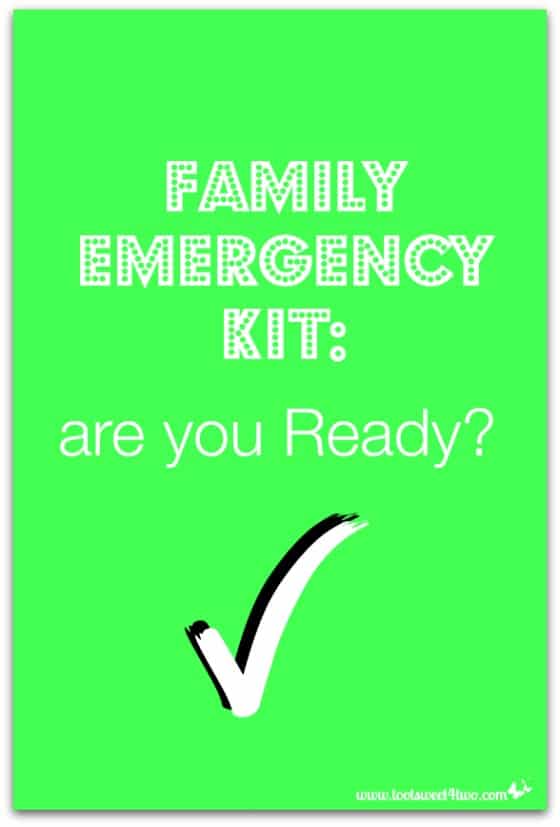
Do you have a Family Emergency Kit? Are you ready? It’s hard to believe, but I’ve been posting monthly on this subject for over six years now. Yes, six! And, it’s been thirteen years since the loss of our home in the 2007 California wildfire, known as the Witch Fire.
Thirteen years ago, we learned from a niece (who learned from her brother and nephew, our neighbor), that our house did not survive. Later we learned that 18 firefighters were on-scene and despite valiant efforts, could not save it. For five days, we were not allowed back into our valley to see our destroyed home or the rest of our property because of elevated concerns over safety from downed power lines and because wildfires were still burning and could change direction with just a shift in the wind pattern.
Those first 5 days, we lived in a hotel. After that, we moved to our relative’s home for 2 weeks. Then, we rented a condo and lived there for 13 months while we rebuilt our home. And, when we moved into that condo, we only had the clothing and few belongings that we took during our evacuation. Plus our cat, Coco. And, none of the stuff we took during our evacuation is listed in this post!
If you are a new reader, welcome to my monthly series about emergency preparedness. I’ve written a 20-part series about the loss of our home in the wildfire and you can read it here: Any Way the Wind Blows.
Also, if you are interested in following along with this series to work on your own emergency preparedness plan, refer back to all these earlier posts for guidance:
- Resolve to Be Ready 2014
- Blackout: are you Ready?
- Pet Owners: are you Ready?
- Evacuation: are you Ready?
- Alert: are you Ready?
- Water: are you Ready?
- Smoke Alarms: are you Ready?
- Emergency Food Supply: are you Ready?
- Fly-Away Kit: are you Ready?
If you are a regular reader of this series, welcome back! Working on your family’s emergency preparedness is an overwhelming job and my hope is that by breaking it down into small tasks a month at a time, this arduous undertaking will become more manageable.
Anyway, way back when, in the first post in this series, Resolve to Be Ready 2014, I advised readers to buy a plastic tub, small enough that when full you can lift it AND one that would fit in your car. If you did, at this point in the journey, this plastic tub only has 2 items in it: your Family Emergency Planning and Resources Binder and a flashlight.
This month, we are going to fill it up!
And, depending on the size of your family, you may need more! But, the key is that you have to be able to lift it and it must fit in your vehicle.
For example: over the years, I’ve seen many who suggest creating this Family Emergency Kit and keeping it in a large, clean, plastic (waterproof) garbage can with a lid – the kind you drag to the curb for pick-up once a week. While this is a good idea for a “shelter-in-place” emergency, if you must leave your premises, you wouldn’t be able to take it with you unless (1) you have one or more big strapping men in your family who could lift it and (2) you have a truck to fit it in!
Although I am married and my husband is a big man, he is handicapped and can’t lift anything like what I’ve described. So, it’s up to me – just as if I were single or a single mom. The other conundrum is that even if you have big strapping men in your family AND a truck, if neither are home at the time of the emergency, it is still up to you.
So, my advice to you? Pack small plastic tubs. They will be easy to handle plus you can finagle them in various configurations to fit in your car along with you, the kids, the pets, and all the other paraphernalia. My mom was a master at packing our car. She loved to camp and my father was often away on assignment (he was in the Air Force). She would pack everything up – tent, sleeping bags, food, clothing, cooking implements, etc. – in boxes, suitcases, etc. and stuff it into our car, into every nook and cranny.
Then, we would sit on top of it. This was pre-seat belt regulations and I can just see all of you mothers out there cringing in disbelief! Yes, we would sit, unbuckled, on top of suitcases in both the back and front seats while she drove us to fabulous camping destinations and other adventures.
By the way, this is “Project #3 – Create your Basic Family Emergency Kit” from the “Emergency Planning Project Checklist” that I created in 2012 and you can access that entire checklist via this link: Emergency Planning Checklist.
Your Family Emergency Kit should include the following (plus containers to store them in):
- First Aid Kit (see my post, What’s in Your First Aid Kit?) including First Aid Book
- Fire Extinguisher
- Matches in a waterproof container and emergency candles (and some kind of candle holder, i.e., candlestick)
- Water – the recommended minimum for evacuation is a 3-day supply of 1 gallon per day per person. So, for a family of four, that would equate to 12 gallons (minimum) on hand. Don’t forget your pets. Include an extra gallon for each pet. The recommended minimum for a shelter-in-place (stay-at-home) emergency is a 2-week supply for each person. See my post, Water: are you Ready?
- Household chlorine bleach and a medicine dropper (to purify water)
- Food – the recommended minimum for evacuation is a 3-day supply for each person and for a stay-at-home emergency, it is a 2-week supply for each person. Please note: food chosen should be non-perishable and low salt to avoid excessive thirst. Be sure to include infant food (if applicable) and don’t forget your pet’s food! See my post: Emergency Food Supply: are you Ready?
- Flashlight and extra batteries
- Radios: NOAA Weather Radio (battery operated or hand-cranked) and a two-way radio
- Maps of your local area
- Sanitation supplies: toilet paper, family wipes, feminine hygiene products, diapers (for infants), adult incontinence products (for elderly family members), plastic garbage/trash/storage bags, soap, hand sanitizer, toothbrushes for each person, and toothpaste, sunscreen
- Blanket and sleeping bags for each family member
- Cell phone chargers (tip: the next time your cell phone plan is up for renewal, change everyone’s cell phone to the same brand so that you can consolidate chargers and not have to buy duplicate chargers for every single cell phone to keep in your family emergency kit).
- Family Emergency Contact Information (see Resolve to be Ready 2014)
- Prescription medication, glasses, and contact lenses; hearing aids with extra batteries, syringes
- Mess kits including cups, plates, eating/cooking/preparing utensils, can & bottle openers, pots and pans, multi-purpose knife (such as a Swiss Army knife)
- Utility shut-off tool and/or multi-purpose tool, whistle, duct tape, magnifying glass
- Copies of personal documents such as medication lists, insurance policies, bank account records, proof of address (such a copy of a utility bill), birth certificates, copy of deed or lease to your home, etc., all stored in a water-proof container (see my post, Fly-Away Kit: are you Ready?).
- Extra cash including change
- Extra set of car keys and household keys
- Paper and pens; games, toys, and activities for your children
- Dust masks, surgical masks, towels (hand towels, bath towels), scissors, plastic sheeting
There you go! That’s the list! But, it is pretty overwhelming, isn’t it? My suggestion: either print my updated Resolve to Be Ready Project Checklist here: Resolve to Be Ready Project Checklist updated 10-22-2014 or print my Emergency Planning Project Checklist (Project #3) and just start tackling it one at a time.
If you don’t have stuff on hand that you can commandeer for this project (for example, sleeping bags) and have to go out and buy them, work them into your budget one item at a time.
If you keep chipping away at this list, before you know it, you will be done!
Tootles,

Related posts about emergency planning and preparedness:
14 Human Needs
Aftermath
Counting Our Blessings
Home Safety Quiz
Hurricane Sandy
In the Midnight Hours
Knockin’ on Heaven’s Door
Replacing Your Important Papers After a Disaster
The Fire Drill
Tornado Alley
Wildfire Season: Are You Ready?
Leave a Reply